Civil Engineering Reference
In-Depth Information
critical being the lowest water-
proofing layer which prevents
water from entering the actual
roof structure. This was once
done using birch bark, but is
now achieved using bitumi-
nous products and plastic mem-
branes. A normal waterproofing
layer is built up in two layers
with a polyethylene membrane
of about 0.5 kg/m
2
on top of a
polyester-reinforced bitumi-
nous felt of about 2 kg/m
2
.
Polyvinyl chloride products are
also used. Bitumen-based glue
and mastic is used for laying
and jointing.
Turf roofs have dominated
building history in northern
Europe as long as can be
remembered. Resources have
been boundless and laying
methods relatively simple,
though labour-intensive. The
high thermal insulation offered
by turf roofing made it a strong
competitor against slate, tiles
and other materials that subse-
quently appeared on the mar-
ket. The thermal insulation
makes it common even in the tropics. There are houses in Tanzania which have
a 40 cm-thick layer of earth with grass on the roof.
Climate has little effect on a turf roof, wherever it is. In very exposed, windy
sites along the coast there are, however, stories of roofs of this type being blown
off. With the demand for even better insulation and less labour-intensive methods
the turf roof became less competitive. Today it is mainly relegated to
Scandinavian summer cottages in the mountains. But during the last 10 years
there has been a renewed interest in this roofing material, because of the ability of
green plants to reduce air pollution noticeably by binding dust, breaking down
gases and producing oxygen. It has been discovered that if 5 per cent of town
roofs were covered with grass and plants, there would be a noticeable reduction
in smog problems. These discoveries have led to heavily-polluted towns in
Figure 15.9: Comparison of the temperatures on roofs covered with
bituminous roofing felt and grass during a period of 24 hours, on a
clear summer day.
Source: H. Luz

